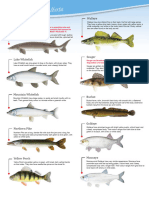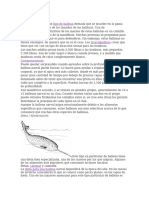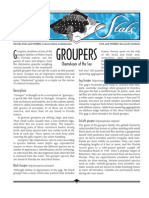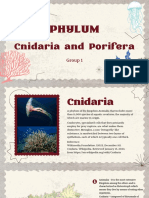Barbs
Barbs
Uploaded by
kozokoCopyright:
Available Formats
Barbs
Barbs
Uploaded by
kozokoOriginal Description:
Copyright
Available Formats
Share this document
Did you find this document useful?
Is this content inappropriate?
Copyright:
Available Formats
Barbs
Barbs
Uploaded by
kozokoCopyright:
Available Formats
Barbs
Generally the Barbus and
Puntius genera Barbs have been selectively bred to
emphasise bright colour combinations
Far Left Top: Rosy Barb
Far Left Bottom: Tiger Barb
Left Top: Striped Barb
Left Bottom: Black Ruby Barb
Below: Odessa Barb
General Information
Barbs belong to the Family Cyprinidae which is one of the Colour and Varieties
largest fish Family’s in the world, and contains more than Barbs have been selectively bred to emphasise colour
2,600 species. The Family consists of a number of bright colour combinations. This group of fish includes
important groups of ornamental fish including Goldfish, popular fish like Rosy Barbs, Moss Green Tiger Barbs,
Loaches, Rasboras and Sharks. Black Ruby Barb, Tiger Barbs, Checker Barbs, Cherry
Barbs and Diamond Scale Barbs.
Natural Range
Southern (Sri Lanka) and Eastern Asia, with a few from Sexing and breeding
Africa. Their natural environment varies from fast flowing Male barbs are generally slender in shape and more
streams and rivers to calmer lake environments. Many brightly coloured than females. Females are also
species also prefer shaded areas with aquatic plants. recognised by their fuller abdomen particularly when in
spawning condition.
Maximum Size
Barbs come in a wide variety of sizes ranging from just a Barbs will readily breed in captivity. For breeding a
few centimetres for the Rosy barb (Puntius conchonius) to separate densely planted tank should be set up and the
the monstrous 35cm for the Tinfoil Barb (Barbus adults should be removed as Barbs do not engage in
schwanenfeldi) making their diversity very impressive. brood care after laying their eggs. Most male barbs
change colour during breeding.
Water Quality
Barbs are not fussy about their water conditions and they Housing
will thrive in parameters such as: The tank set up should avoid bright lights as a moderate
Temperature: 18 oC – 26oC amount of light will bring out the best colours on them
pH: 6.5 – 7. 5 more effectively. Secondly provide a lot of swimming
General Hardness: 50 – 150 ppm space and hiding places for these active fish. Barbs are
undemanding and will be a stunning addition to the home
Feeding aquarium.
They are omnivorous and will thrive on live, frozen and dry
food. It is also a good idea to provide some vegetable
matter as well.
Compatibility
Barbs are hardy, active and mostly a peaceful fish that are
best kept in groups in a community tank. Tiger Barbs are
known to nip at fins therefore it is best not to keep them
with long finned fish and with small slow moving fish.
Provide enough fish to school and the fin nipping tendency
will be lessened.
Golden Tiger Barb
2014
You might also like
- Seymour Simon - Sharks-Scholastic Inc. (1995)Document36 pagesSeymour Simon - Sharks-Scholastic Inc. (1995)lakshmi0vinay60% (5)
- Lions V TigersDocument2 pagesLions V TigersvNo ratings yet
- Animal 4Document1 pageAnimal 4Putri Dwi DarmianiNo ratings yet
- Community Fish - A GuideDocument5 pagesCommunity Fish - A GuideStratosNo ratings yet
- Bronze Corydoras Fish Species ProfileDocument1 pageBronze Corydoras Fish Species ProfileLuke SpinnerNo ratings yet
- Behviuor of Molly Guppy and Zebra FishDocument23 pagesBehviuor of Molly Guppy and Zebra FishmonikaNo ratings yet
- Barb ProfileDocument5 pagesBarb ProfileNetrananda SahuNo ratings yet
- TYPES-OF-FISH_20241029_150244_0000Document10 pagesTYPES-OF-FISH_20241029_150244_0000irisclaire24No ratings yet
- Rasbora HarlequinDocument1 pageRasbora HarlequinkozokoNo ratings yet
- Ornamental FisheriesDocument10 pagesOrnamental Fisheriesmanasmehrotra769No ratings yet
- Snake PoisoningDocument47 pagesSnake Poisoning126.NishkaraniNo ratings yet
- Java BarbDocument16 pagesJava BarbTita EnestyaNo ratings yet
- Amphibian of PK Part OneDocument30 pagesAmphibian of PK Part OnemuneebhankNo ratings yet
- SnakesDocument9 pagesSnakesDrAmit DuttaNo ratings yet
- Native Fish Species of Begnas and Rupa Lakes: A) U GFDocument28 pagesNative Fish Species of Begnas and Rupa Lakes: A) U GFAnjali Poudel100% (1)
- Anabantoids Betta TimeDocument34 pagesAnabantoids Betta TimeNguyen Trung DaiNo ratings yet
- Platy FishDocument2 pagesPlaty FishVivek RNo ratings yet
- Wildlife Fact File - Fish - Pgs. 1-10Document20 pagesWildlife Fact File - Fish - Pgs. 1-10ClearMind84100% (2)
- SnakesDocument49 pagesSnakesloksewa739No ratings yet
- Freshwater Fish Sydney Region - POSTER - 2003Document2 pagesFreshwater Fish Sydney Region - POSTER - 2003donny sophandiNo ratings yet
- Polar Bear VSDocument9 pagesPolar Bear VSbigoroxNo ratings yet
- AsiacoonDocument10 pagesAsiacoonpaul.mallardNo ratings yet
- HIPPOCAMPUSDocument12 pagesHIPPOCAMPUSMadhav GoelNo ratings yet
- Major Cultivable Fish Species: Speaker: Dr. M.Das TrakrooDocument42 pagesMajor Cultivable Fish Species: Speaker: Dr. M.Das TrakroojoshigautaNo ratings yet
- Sharks (Marine Studies Yr9 ) FinalDocument44 pagesSharks (Marine Studies Yr9 ) Finalemily.sonter2No ratings yet
- NMFS Species ManualDocument125 pagesNMFS Species ManualRosalie GomezNo ratings yet
- Silver Arowana Care - Diet, Health, Tank Setup, and DiseasesDocument20 pagesSilver Arowana Care - Diet, Health, Tank Setup, and Diseasesraduv4003No ratings yet
- Pg1 2 Sport Fish IdentificationDocument3 pagesPg1 2 Sport Fish IdentificationLuc CardNo ratings yet
- Presentation2 (2)Document38 pagesPresentation2 (2)SAMRITI SHARMANo ratings yet
- As - Swine ProductionDocument8 pagesAs - Swine Productionlemuel d. antipordaNo ratings yet
- Animal HabitatDocument10 pagesAnimal HabitatJG GoliniaNo ratings yet
- Animal Raising Cattle - 20241005 - 121720 - 0000Document3 pagesAnimal Raising Cattle - 20241005 - 121720 - 0000tm.cmrtzNo ratings yet
- Zebra Shark FINALDocument2 pagesZebra Shark FINALhumerahume1111No ratings yet
- Parambassis Ranga: Classification Distribution Habitat Maximum Standard Length Aquarium Size MaintenanceDocument15 pagesParambassis Ranga: Classification Distribution Habitat Maximum Standard Length Aquarium Size MaintenancePieter SteenkampNo ratings yet
- Have Dorsal and Anal Fins Usually Have Pelvic Fins With One Spine and Up To Five Soft RaysDocument4 pagesHave Dorsal and Anal Fins Usually Have Pelvic Fins With One Spine and Up To Five Soft RaysJeric Ampalaya PresasNo ratings yet
- Marine Fish For Beginners EbookDocument12 pagesMarine Fish For Beginners Ebookpule rikyNo ratings yet
- Red Stripe BarbDocument2 pagesRed Stripe BarbnsutardiNo ratings yet
- Ballena NarvalDocument2 pagesBallena Narvalmontserratg096No ratings yet
- Tambahkan Sedikit Teks IsiDocument1 pageTambahkan Sedikit Teks Isinurul hudayaNo ratings yet
- Lets Talk Snakes 29072021Document71 pagesLets Talk Snakes 29072021pubglife3524No ratings yet
- Arowana Dynasty SDN - Bhd. Company HistoryDocument11 pagesArowana Dynasty SDN - Bhd. Company HistorySuja ShanNo ratings yet
- Black Moor GoldfishDocument11 pagesBlack Moor GoldfishGogo PNo ratings yet
- Fish & ShellfishDocument5 pagesFish & ShellfishDomuNo ratings yet
- Compare and Contrast - Lions and Tigers: HabitatDocument2 pagesCompare and Contrast - Lions and Tigers: HabitatValenzia Ayu Mahartanti0% (1)
- Discus Care SheetDocument2 pagesDiscus Care SheetkozokoNo ratings yet
- Tiger-SharkDocument2 pagesTiger-Sharkpooven.sivakumarNo ratings yet
- 11 SITHCCC013 Assessment Task 2 ProjectDocument13 pages11 SITHCCC013 Assessment Task 2 ProjectSneha DhamijaNo ratings yet
- Fire Belly ToadsDocument12 pagesFire Belly ToadsAmy Thomas StanislawskiNo ratings yet
- Breeds of CattleDocument38 pagesBreeds of CattleCARL SEAN MARGATENo ratings yet
- Lake Estes: Fish Survey and Management DataDocument1 pageLake Estes: Fish Survey and Management DataHeryanto ChandrawarmanNo ratings yet
- Tiger Barbs PDFDocument14 pagesTiger Barbs PDFamitdesai1508No ratings yet
- 29. snakes 2_e98599b8-0b2b-4288-ba54-e00b0154b160Document6 pages29. snakes 2_e98599b8-0b2b-4288-ba54-e00b0154b160Kumkum MauryaNo ratings yet
- Liver Trematodes (Dahman, A.)Document5 pagesLiver Trematodes (Dahman, A.)Med LawNo ratings yet
- Trash Fish of Malvan ID Guide Final 10-04-21Document94 pagesTrash Fish of Malvan ID Guide Final 10-04-21SammyisPlayingAltNo ratings yet
- CARE SHEET Emydura Subglobosa - 098 - 202005040938Document2 pagesCARE SHEET Emydura Subglobosa - 098 - 202005040938Jessica TjungNo ratings yet
- Wonder Fish: Welcome To The Amazing World of FishesDocument16 pagesWonder Fish: Welcome To The Amazing World of FishesSaubhik DeyNo ratings yet
- Sea Stats - GroupersDocument4 pagesSea Stats - GroupersFlorida Fish and Wildlife Conservation CommissionNo ratings yet
- TB No.16 PDFDocument19 pagesTB No.16 PDFJohnNo ratings yet
- Rasbora HarlequinDocument1 pageRasbora HarlequinkozokoNo ratings yet
- Gourami ChocolateDocument1 pageGourami ChocolatekozokoNo ratings yet
- Setting Up A Freshwater AquariumDocument1 pageSetting Up A Freshwater AquariumkozokoNo ratings yet
- All About Begonias2Document3 pagesAll About Begonias2kozokoNo ratings yet
- Discus Care SheetDocument2 pagesDiscus Care SheetkozokoNo ratings yet
- Aquarium PlantsDocument59 pagesAquarium PlantsLeonard Mandes100% (7)
- Derek Lambert-A Practical Guide To Breeding Your Freshwater Fish (Tankmasters Series) - Barron (2001)Document81 pagesDerek Lambert-A Practical Guide To Breeding Your Freshwater Fish (Tankmasters Series) - Barron (2001)kozokoNo ratings yet
- Egg Depositor of Ornamental FishesDocument4 pagesEgg Depositor of Ornamental FishesPieter SteenkampNo ratings yet
- T SC 2550837 ks2 Shark Information Posters 1 - Ver - 1Document8 pagesT SC 2550837 ks2 Shark Information Posters 1 - Ver - 1lepanhalidNo ratings yet
- Philippine Fish SpeciesDocument5 pagesPhilippine Fish SpeciesMayda RiveraNo ratings yet
- Seafood Price ComparisonDocument5 pagesSeafood Price ComparisonSapri SuhailiNo ratings yet
- Phylum Cnidaria and Porifera Group 1Document32 pagesPhylum Cnidaria and Porifera Group 1JulesNo ratings yet
- Exported Fish and Fishery Products From MyanmarDocument28 pagesExported Fish and Fishery Products From MyanmarKhineJay100% (1)
- Cichlids AfricanDocument2 pagesCichlids AfricanPablo NavaNo ratings yet
- AdventuresDocument4 pagesAdventuresnt177982No ratings yet
- The Classification of Phylum CnidariaDocument3 pagesThe Classification of Phylum CnidariaFikri AndrianNo ratings yet
- Phylum CnidariaDocument2 pagesPhylum CnidariaHafizah ZakiahNo ratings yet
- Adaptations of Aquatic Animals MinDocument3 pagesAdaptations of Aquatic Animals MinNilkanth DesaiNo ratings yet
- Fish DiversityDocument23 pagesFish DiversityHadia KhadijaNo ratings yet
- Learn With Pictures S1 #20 Marine Animals: Lesson NotesDocument3 pagesLearn With Pictures S1 #20 Marine Animals: Lesson NotesZaid OviNo ratings yet
- Fish Fillet Yields Form ChartDocument7 pagesFish Fillet Yields Form ChartIndrajitNo ratings yet
- Aqu247 Lab Report 2 Syafiz Iqmal 2019412616Document9 pagesAqu247 Lab Report 2 Syafiz Iqmal 2019412616SYAFIZ IQMAL RAMLANNo ratings yet
- Act Sheet 15 Systematic Zoology 01 ExerciseDocument8 pagesAct Sheet 15 Systematic Zoology 01 ExerciseDusseldon ValenciaNo ratings yet
- EDF Pocket Seafood SelectorDocument2 pagesEDF Pocket Seafood Selectortakepart100% (2)
- Characteristics of InvertebratesDocument6 pagesCharacteristics of InvertebratesMary Eilleen CabralNo ratings yet
- Tuna Types Caught in Indonesian WatersDocument2 pagesTuna Types Caught in Indonesian WatersElizabethNo ratings yet
- AkuaDocument19 pagesAkuaFarhan ShabriNo ratings yet
- Top Fish-SpeciesDocument20 pagesTop Fish-SpeciesswogtfNo ratings yet
- Valuation Report - by Country of Origin / Commodity: HS Code: 03038990 Other Fish, Excluding Livers and RoesDocument25 pagesValuation Report - by Country of Origin / Commodity: HS Code: 03038990 Other Fish, Excluding Livers and Roesraju ahmedNo ratings yet
- PolymorhismDocument3 pagesPolymorhismamit545No ratings yet
- Phylum Porifera PDFDocument17 pagesPhylum Porifera PDFkingNo ratings yet
- Albay Gulf Fish Guide - NfrdiDocument190 pagesAlbay Gulf Fish Guide - NfrdiNorlinah TucaloNo ratings yet
- Act 15 Gollon, Hanz. Chua Valiant SYSTEMATIC ZOOLOGY 01Document7 pagesAct 15 Gollon, Hanz. Chua Valiant SYSTEMATIC ZOOLOGY 01s9036282No ratings yet
- Cartagena de Indias: Leidy PrietoDocument3 pagesCartagena de Indias: Leidy PrietoPedro José GonzálezNo ratings yet
- Argumentative EssayDocument2 pagesArgumentative EssaykaylaNo ratings yet
- Sea Animals (TK)Document6 pagesSea Animals (TK)Aka PutraNo ratings yet






























































































